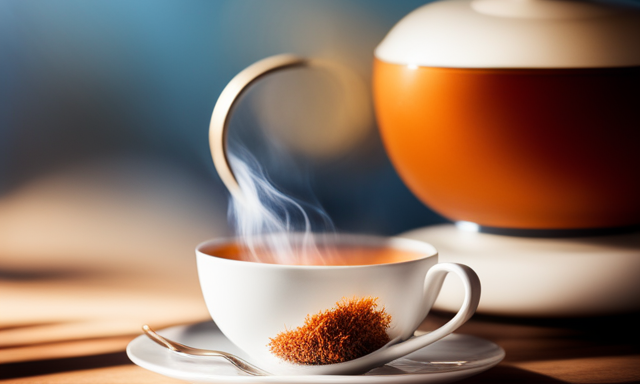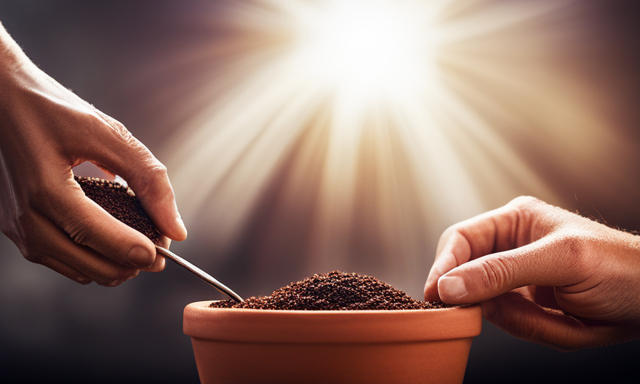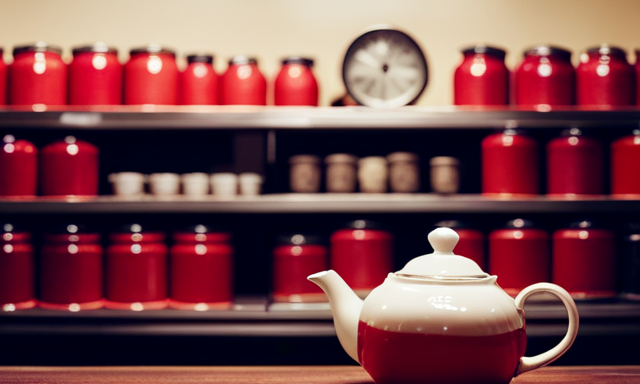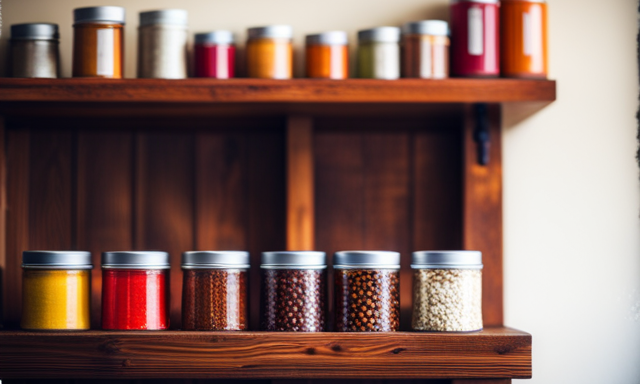What does rooibos tea taste like?
It’s a question that has intrigued me ever since I first heard about this unique South African beverage. As a tea enthusiast, I am always seeking out new flavors and experiences, and rooibos tea promised to be a delightful addition to my collection.
So, armed with a curious palate and a thirst for knowledge, I set out to uncover the secrets of this renowned tea.
In my quest, I discovered the fascinating origin and history of rooibos tea, as well as the meticulous cultivation and harvesting process that contributes to its distinctive flavor profile. I learned about the health benefits it provides and the various varieties and blends available.
I even explored the art of pairing rooibos tea with different foods to enhance the overall tasting experience. Along the way, I uncovered its presence in popular culture and delved into the sustainability and ethical considerations surrounding its production.
Now, join me as I unveil the tantalizing taste of rooibos tea, a sensory journey like no other.
Key Takeaways
- Rooibos tea has an earthy and slightly sweet flavor.
- The taste of rooibos tea can be enhanced with sweeteners like honey and flavors like lemon and vanilla.
- It is typically brewed with water at a temperature of 200°F (93°C) for 5-7 minutes.
- Rooibos tea can be enjoyed hot or cold and pairs well with desserts, both sweet and savory dishes.
Origin and History of Rooibos Tea
Did you know that Rooibos tea has a fascinating origin and history? This unique herbal tea originates from the Cederberg region of South Africa, where it has been cultivated for centuries.
The indigenous Khoisan people were the first to discover the delicate leaves of the Rooibos plant and brew them into a delicious and aromatic beverage. Over time, the cultivation techniques were refined, and the health benefits of Rooibos tea were discovered.
Rich in antioxidants, vitamins, and minerals, this caffeine-free tea is known for its soothing properties and ability to reduce inflammation. As I delve into the subsequent section about the cultivation and harvesting process, you’ll discover the intricate steps involved in bringing this remarkable tea from plant to cup.
The Cultivation and Harvesting Process
Immerse yourself in the sun-drenched fields of South Africa, where the delicate leaves of the rooibos plant are lovingly plucked and harvested by skilled hands. Cultivation techniques for rooibos tea involve careful attention to detail, as the plant requires unique conditions to thrive. The rooibos plant, also known as Aspalathus linearis, grows exclusively in the Cederberg region of South Africa. It thrives in sandy soil and requires a Mediterranean climate with hot, dry summers and cool, wet winters. Farmers employ sustainable farming practices to minimize the environmental impact of cultivation, such as crop rotation and organic fertilizers. The harvesting process involves handpicking the leaves, which are then fermented and dried to enhance their flavor. This careful cultivation and harvesting process contributes to the distinct and unparalleled taste of rooibos tea. Transitioning to the subsequent section, the unique flavor profile of rooibos tea is a result of these meticulous cultivation techniques.
Unique Flavor Profile of Rooibos Tea
When it comes to the unique flavor profile of rooibos tea, I’m immediately drawn to its earthy and sweet notes. There’s a delightful balance between these two flavors, creating a harmonious blend that’s both comforting and satisfying.
Additionally, I can detect a subtle hint of nuttiness, adding depth and complexity to the tea.
Overall, the taste of rooibos tea is smooth and refreshing, making it a perfect choice for a relaxing afternoon indulgence.
Earthy and Sweet Notes
The rooibos tea has a delightful taste, with its earthy and sweet notes blending together in a harmonious dance on the palate. It is a truly unique experience, one that is both comforting and invigorating.
-
The earthy flavor of rooibos tea is reminiscent of the rich soil from which it’s grown. It adds a sense of grounding to each sip, making it perfect for a moment of relaxation or meditation.
-
Aside from its delicious taste, rooibos tea also boasts numerous health benefits. Its earthy notes are a result of the antioxidants and minerals present in the leaves, which can contribute to improved immune function and reduced inflammation.
-
The sweetness of rooibos tea is subtle yet satisfying, adding a touch of natural sweetness without overpowering the senses. It provides a gentle contrast to the earthy undertones, creating a well-rounded flavor profile that’s both complex and comforting.
As the earthy and sweet notes fade, a hint of nuttiness emerges, inviting you to explore the next facet of this remarkable tea.
A Hint of Nuttiness
As you sip on this remarkable brew, your taste buds will be delighted by a subtle hint of nuttiness that adds a fascinating dimension to the overall flavor profile. The nutty undertones of rooibos tea evoke a sense of warmth and richness, reminiscent of toasted almonds or pecans. This unique characteristic sets it apart from other beverages, as the nuttiness brings a comforting element to the tea.
Interestingly, nuts themselves are known for their numerous health benefits, such as improving heart health and boosting brain function. Similarly, rooibos tea contains high levels of antioxidants, further enhancing its appeal as a healthy choice.
Transitioning seamlessly into the subsequent section about the smooth and refreshing taste, the nuttiness in rooibos tea adds complexity and depth, elevating it to a truly satisfying beverage.
Smooth and Refreshing Taste
As I continue to explore the flavors of rooibos tea, I’m captivated by its smooth and refreshing taste. With each sip, I’m transported to a serene oasis, feeling a wave of tranquility wash over me. The subtle nuttiness from the previous subtopic adds depth to the overall experience, creating a harmonious balance that’s truly delightful.
The smoothness of the tea caresses my palate, leaving a gentle sweetness that lingers on my tongue.
Beyond its exquisite taste, rooibos tea is also renowned for its numerous health benefits. Packed with antioxidants and minerals, this herbal infusion boosts the immune system, promotes healthy digestion, and even aids in relaxation. Its caffeine-free nature makes it a perfect choice for those seeking a soothing beverage without the jitters.
With each sip, I can’t help but appreciate the harmony between flavor and wellness that rooibos tea offers.
Transitioning into the subsequent section, let’s now delve deeper into the remarkable health benefits of this remarkable tea.
Health Benefits of Rooibos Tea
Discover the amazing health benefits of rooibos tea and how it can improve your well-being!
Rooibos tea is not only known for its smooth and refreshing taste, but also for its numerous health benefits. This antioxidant-rich beverage can boost your immune system, helping to protect your body against harmful free radicals.
The high levels of antioxidants found in rooibos tea can also promote healthy skin, reducing the signs of aging and improving overall complexion. Additionally, rooibos tea has been found to aid in digestion, soothing stomach discomfort and reducing inflammation.
As you explore the world of rooibos tea varieties and blends, you will be delighted by the endless possibilities for creating unique and flavorful experiences.
Transitioning into the next section, let’s delve into the diverse range of rooibos tea varieties and blends.
Rooibos Tea Varieties and Blends
With its diverse range of flavors and combinations, rooibos tea varieties and blends offer a vibrant tapestry of taste sensations to explore. From the earthy and slightly sweet flavors of plain rooibos, to the fruity and floral notes of rooibos blends infused with berries or flowers, there is something for every palate.
One can indulge in the smooth and creamy taste of vanilla rooibos, or savor the zesty and refreshing flavors of citrus-infused rooibos tea. These blends not only provide a delightful drinking experience, but also harness the numerous health benefits of rooibos tea. Rich in antioxidants and packed with essential minerals, rooibos tea supports immune function, aids digestion, and promotes overall well-being.
As we delve into the art of brewing and serving rooibos tea, one can truly appreciate the versatility and complexity of this exquisite beverage.
Brewing and Serving Rooibos Tea
When it comes to brewing and serving rooibos tea, there are a few key points to keep in mind. First and foremost, the proper water temperature and steeping time are crucial in extracting the full flavor of the tea. I find that using water that’s just below boiling and steeping the tea for 5-7 minutes creates a rich and robust infusion.
Additionally, some people enjoy adding sweeteners or enhancements to their rooibos tea, such as honey or a squeeze of lemon, to further enhance the flavors.
Lastly, rooibos tea can be enjoyed both hot and cold, depending on personal preference and the weather. Personally, I find that sipping a hot cup of rooibos tea is comforting and soothing, while a chilled glass of iced rooibos tea is refreshing and revitalizing on a hot summer day.
Proper Water Temperature and Steeping Time
To get the perfect cup of rooibos tea, start by boiling the water to the proper temperature and then steep it for the recommended time to unlock its delightful flavors.
The proper water temperature for brewing rooibos tea is around 200°F (93°C). This temperature allows the tea leaves to release their vibrant and aromatic oils, resulting in a smooth and satisfying taste.
Steeping time is equally important, as it determines the strength and depth of the flavor. For rooibos tea, a steeping time of 5-7 minutes is generally recommended. This allows the tea to fully infuse the water, creating a rich and full-bodied cup.
Once the steeping time is complete, it’s time to move on to the next step – adding sweeteners or enhancements – to further enhance the taste and experience.
Adding Sweeteners or Enhancements
Enhancing the flavor of your cup of rooibos tea is as simple as adding a touch of sweetness or a unique twist. There are several sweeteners and flavor enhancers that can transform the taste of your tea into a delightful experience. Here are a few options to consider:
-
Honey: It’s natural sweetness adds a subtle floral note to the earthy flavor of rooibos tea.
-
Lemon: Squeezing a few drops of lemon juice into your tea can bring a refreshing citrusy zing.
-
Vanilla: A splash of vanilla extract can bring a creamy and aromatic dimension to your cup.
These additions can complement the natural taste of rooibos tea and create a more personalized blend. Experiment with different combinations to find your perfect cup.
Now, let’s explore the ways you can enjoy your rooibos tea, whether it’s hot or cold.
Enjoying it Hot or Cold
Sip your cup of rooibos tea, whether steaming hot or ice-cold, and let it transport you to a world of pure relaxation and bliss.
The soothing warmth of a hot cup of rooibos tea can be incredibly comforting, especially on a chilly day. The tea’s natural sweetness and earthy undertones are enhanced when enjoyed with a touch of milk, adding a creamy richness to each sip.
Alternatively, on a warm summer day, a glass of refreshing iced rooibos tea can be the perfect thirst-quencher.
And for those looking to explore new culinary possibilities, why not try experimenting with rooibos tea cocktails? The unique flavors of this tea can add a delightful twist to your favorite mixed drink.
As we transition to the next section on pairing rooibos tea with food, let’s explore the harmonious relationship between this exquisite beverage and delectable cuisines.
Pairing Rooibos Tea with Food
When it comes to pairing food with rooibos tea, the rich and earthy flavors of the tea complement a variety of dishes. Whether it’s pairing rooibos tea with desserts or exploring rooibos tea cocktails, the possibilities are endless.
The natural sweetness of the tea makes it a perfect match for indulgent treats like chocolate cake or creamy cheesecake. The warm, comforting notes of rooibos also lend themselves well to creating unique and flavorful cocktails, such as a rooibos-infused gin and tonic or a refreshing rooibos mojito.
The versatility of rooibos tea allows it to enhance the flavors of both sweet and savory dishes, making it a delightful addition to any meal.
Transitioning into the subsequent section about ‘rooibos tea in popular culture’, this beloved beverage has made its mark in various culinary and cultural spheres.
Rooibos Tea in Popular Culture
As we explored the delightful pairings of Rooibos Tea with food, it becomes clear that this aromatic beverage is not just a simple drink, but a versatile ingredient that can enhance various culinary creations. Now, let’s delve into the realm of Rooibos Tea in Popular Culture. From books to movies, this unique tea has made appearances in creative works, evoking a sense of warmth and comfort. Its distinct flavor and soothing properties have inspired many to experiment with Rooibos tea recipes, incorporating it into desserts, cocktails, and even savory dishes. Moreover, the health benefits of Rooibos tea have gained attention, as it is known to be rich in antioxidants and have anti-inflammatory properties. As we explore the world of Rooibos tea, it is important to also consider its sustainability and ethical considerations. [SUBSEQUENT SECTION: ‘Sustainability and Ethical Considerations’]
Sustainability and Ethical Considerations
To truly appreciate the impact of Rooibos Tea, you must consider the ethical footprint it leaves on the world, as well as the sustainability practices behind its production.
Rooibos tea is not just a delicious beverage; it’s the result of sustainable farming methods that prioritize the health of the environment. The tea is grown in the Cederberg region of South Africa, where farmers have embraced organic practices and a deep respect for the land.
Additionally, many Rooibos tea producers adhere to fair trade principles, ensuring that the farmers are paid fair wages and work in safe conditions. By supporting Rooibos tea, you’re not only indulging in a flavorful experience but also contributing to a more sustainable and equitable world.
Now, let’s explore where to buy and try Rooibos tea.
Where to Buy and Try Rooibos Tea
You can easily find and experience the rich flavors of Rooibos tea at various specialty tea shops and online retailers. When it comes to buying options, there are a plethora of choices available.
Some reputable online retailers include Adagio Teas and The Republic of Tea, where you can find a wide selection of Rooibos tea blends and flavors.
Additionally, specialty tea shops like Teavana and David’s Tea offer an immersive experience where you can sample different varieties of Rooibos tea before making a purchase.
As for health benefits, Rooibos tea is known for its antioxidant properties and its ability to promote relaxation and improve digestion.
With its earthy, slightly sweet flavor and numerous health benefits, Rooibos tea is a delightful beverage option to explore.
Frequently Asked Questions
What is the caffeine content of rooibos tea?
Rooibos tea has no caffeine content, making it a great choice for those looking to avoid stimulants. Despite this, it still offers a myriad of health benefits, including antioxidant properties and potential improvements in heart health.
Can rooibos tea be consumed by individuals with certain dietary restrictions?
Deliciously smooth and naturally sweet, rooibos tea can be enjoyed by individuals with diabetes and gluten intolerance. Its soothing properties make it a perfect option for those with dietary restrictions, providing a flavorful and health-conscious choice.
Does rooibos tea require any special storage conditions?
Rooibos tea should be stored in special conditions to maintain its freshness and flavor. It is recommended to store it in an airtight container in a cool, dry place away from direct sunlight. Temperature requirements are crucial for preserving its quality.
Are there any potential side effects or precautions to consider when consuming rooibos tea?
Consuming rooibos tea is a treacherous affair. The potential health benefits, like improved heart health and digestion, are enticing. However, one must exercise caution and not exceed the recommended daily intake to avoid any adverse effects.
How does the price of rooibos tea compare to other types of tea?
When comparing the price of rooibos tea to other types of tea, it tends to be on the higher end due to its popularity and unique flavor profile. People are willing to pay more for its rich, earthy taste and health benefits.
Conclusion
In conclusion, after immersing myself in the rich world of rooibos tea, I’ve discovered a beverage that’s truly a sensory masterpiece.
With its enchanting amber hue and earthy aroma, this tea beckons you to indulge in its velvety smoothness. As each sip dances on your palate, notes of honeyed sweetness intermingle with hints of vanilla and caramel, creating a symphony of flavors that’s both comforting and invigorating.
Like a warm embrace on a chilly evening, rooibos tea is a captivating elixir that transports you to a world of tranquility and delight.










